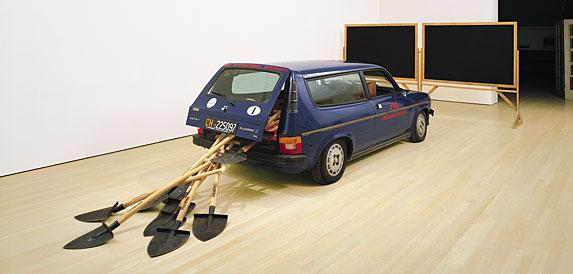Joseph Beuys Gallery
Automobile, shovels, copper pieces, pamphlets, and slate blackboard, dimensions vary with installation. Solomon R. Guggenheim Museum. 85.3315.a-.e. Joseph Beuys
By 1962 Beuys had ceased creating objects, turning his attention to Performance [more] art and sculptural experiments with nontraditional materials. F. I. U.: The Defense of Nature exemplifies the way his life came to merge with his art. The work refers to an ecological campaign that Beuys and his dealer, Lucrezia de Domizio, waged in the 1980s with the help of his students at the art academy he had founded to encourage creativity—the Free International University (hence the F. I. U. of the title). The campaign required the use of a car, pamphlets, copper tubing, and spades that were meant to be plunged vigorously into the Italian countryside. Beuys sold the car, its contents, and two blackboards as part of his routine transformation of performance materials into artworks that would in turn fund other projects.

viewer |
|
|
| Felt Suit |
Defense of Nature, |
| Animal Woman |
| Encounter with Beuys |
| Terremoto |
| Virgin |
| Virgin1979 |
Biography
Bulletin Board
Renowned Art
(home)
Joseph Beuys was in Krefeld but grew up mainly in two nearby towns, Kleve and Rindern. Beuys became associated with the Fluxus movement, eventually becoming its most significant and famous member. He moved from drawing toward performance art motivated by his belief that art has a larger role to play in society. In 1979 Beuys became a founding member of the German Green Party.
all artists, with thumbnails: by birth year | alphabetically
all artists: by birth year | alphabetically
artists born in the 13th 14th 15th 16th 17th 18th 19th 20th century